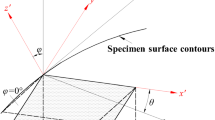Abstract
This work is to introduce a new model for fatigue life prediction. At first, considering the weakening speed of weight function in the stress field of intensity method is too fast, a modification is presented to make it more suitable for the calculation of the fatigue life of the key components. In this model the stress contour line was proposed as the boundary of the damage zone and a new mathematical model for stress gradient was constructed. Then, the determination of the damage zone and the direction angle were given. Numerical simulations were performed to analyze the proposed new method. On the basis of the new stress field of intensity method, two examples were analyzed and calculated. Compared with the traditional method, the damage zone determined by the improved stress field method can change with the load amplitude, and it is closer to the shape and size of the real damage zone. The experiment effectively verifies the rationality of the new mathematical model and the feasibility of this new approach. With the small error and good stability, this new approach can be well used in the fatigue life prediction of notched specimen.
Similar content being viewed by others
References
Abreu, L. M. P., Costa, J. D., and Ferreira, J. A. M. (2005). “Fatigue behaviour of almgsi tubular specimens subjected to bending–torsion loading.” International Journal of Fatigue, Vol. 31, No. 8, pp. 1327–1336, DOI: 10.1016/j.ijfatigue.2009.03.004.
Adib-Ramezani, H. and Jeong, J. (2007). “Advanced volumetric method for fatigue life prediction using stress gradient effects at notch roots.” Computational Materials Science, Vol. 39, No. 3, pp. 649–663, DOI: 10.1016/j.commatsci.2006.08.017.
Chen, J., Cui, H. T., and Wen, W. D. (2010). “Study on fatigue life prediction method of gap components based on stress field strength.” Journal of Changchun University of Technology (Natural Science Edition), Vol. 33, No. 4, pp. 87–91, DOI: 10.3969/j.issn.1672-9870. 2010.04.025.
Conle, F. A. and Chu, C. (1997). “Fatigue analysis and the local stress–strain approach in complex vehicular structures.” International Journal of Fatigue, Vol. 19, No. 97, pp. 317–323, DOI: 10.1016/S0142-1123(97)00045-5.
Guo, H. D. and Wu, Q. (2008). “Way to evaluate fatigue life of fillet weld of plate with flange based on stress field intensity.” Journal of Aerospace Power, Vol. 23, No. 6, pp. 1082–1086.
Lazzarin, P., Lassen, T., and Livieri, P. (2010). “A notch stress intensity approach applied to fatigue life predictions of welded joints with different local toe geometry.” Fatigue & Fracture of Engineering Materials & Structures, Vol. 26, No. 1, pp. 49–58, DOI: 10.1046/j.1460-2695.2003.00586.x.
Li, Y., Li, X. D., Xia, T. X., Yue, N., Gong, Q., and Wen, F. (2016). “Fatigue life prediction and experimental study on a compressor rotary table of a type of aircraft engine by stress field intensity method.” Engineering Mechanics, Vol. 33, No. 7, pp. 220–226, DOI: 10.6052/j.issn.1000-4750.2014. 12.1058.
Li, D. and Yao, W. X. (2011). “Nominal stress approach for life prediction of notched specimens under vibration loading.” Acta Aeronautica Et Astronautica Sinica, Vol. 32, No. 11, pp. 2036–2041.
Maxime, C., Matteo, B., and Pierre, D. (2016). “Topology optimization for minimum weight with compliance and simplified nominal stress constraints for fatigue resistance.” Structural & Multidisciplinary Optimization, pp. 1–17, DOI: 10.1007/s00158-016-1510-6.
Shang, D. G., Wang, D. K., Li, M., and Yao, W. X. (2001). “Local stress–strain field intensity approach to fatigue life prediction under random cyclic loading.” International Journal of Fatigue, Vol. 23, No. 10, pp. 903–910, DOI: 10.1016/S0142-1123(01)00051-2.
Shen, J. B. and Tang, D. L. (2016) “Study of field size parameter in stress field intensity approach.” Chinese Journal of Engineering Design, Vol. 23, No. 1, pp. 22–27, DOI: 10.3785/j.issn.1006-754X. 2016.01.004.
Wang, Z. B. (2003). “Nominal stress approach for fatigue life estimation under corrosive environment.” Journal of Beijing University of Aeronautics & Astronautics, Vol. 29, No. 2, pp. 161–164, DOI: 10.1007/BF02974893.
Xia, T. X., Yao, W. X., and Gao, Y. J., (2016). “A novel shear fatigue parameter considering the stress gradient effect.” Engineering Mechanics, Vol. 33, No. 10, pp. 243–247, 256, DOI: 10.6052/j.issn. 1000-4750.2015.03.0218.
Yan, R. J., Zhou, H. F., Liu, H., and Luo, Z. M. (2014). “Study on lowcycle fatigue at butt joint of HTS-A steel.” Journal of Ship Mechanics, Vol. 18, No. 1, pp. 152–157, DOI: 10.3969/j.issn.1007-7294.2014.h1.019.
Yao, W. X., Ye, B., and Zheng, L. C. (2001). “A verification of the assumption of anti-fatigue design.” International Journal of Fatigue, Vol. 23, No. 3, pp. 271–277, DOI: 10.1016/S0142-1123(00)00083-9.
Zhang, Z. L. and Yao, W. X. (2004). “Local stress approach for fatigue life prediction of polymethyl methacrylate members.” Journal of Nanjing University of Aeronautics & Astronautics, Vol. 36, No. 3, pp. 298–301.
Zhao, X. F., Wang, Y. H., and Cui, Y. J. (2012). “The application of strain field intensity method in the steel bridge fatigue life evaluation.” Proc. SPIE, Nondestructive Characterization for Composite Materials, Aerospace Engineering, Civil Infrastructure, and Homeland Security 2012, SPIE, Bellingham, WA, USA, Vol. 8347, pp. 61, DOI: 10.1117/12.915096.
Author information
Authors and Affiliations
Corresponding author
Rights and permissions
About this article
Cite this article
Tang, D., Hou, J., Ma, Z. et al. Fatigue Life Predictions based on a New Stress Field Intensity Approach. KSCE J Civ Eng 23, 2198–2203 (2019). https://doi.org/10.1007/s12205-019-0836-1
Received:
Revised:
Accepted:
Published:
Issue Date:
DOI: https://doi.org/10.1007/s12205-019-0836-1




